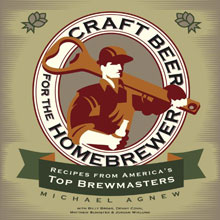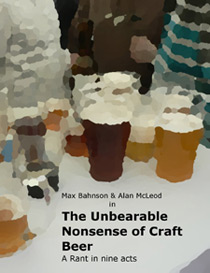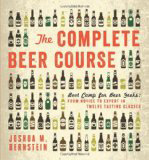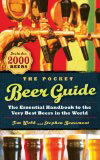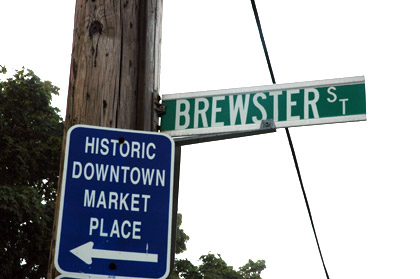(Boak and Bailey are “going long” on Nov. 30 and asked other writers to join them. I’ve jumped the gun by a few days because what might best be described as logistical reasons. Be sure to look for their “longer than usual post” the 30th. The Twitter hashtag #beerylongreads might help you find more.)
Not long after Geoff Larson dumped the thirteenth batch of what would eventually be the first brand Alaskan Brewing sold he poured out the fourteenth. Then the fifteenth, and the sixteenth.
“Oh, boy, that was painful, very painful,” said brewery co-founder Marcy Larson, Geoff’s wife. She kept the books, so she understood perfectly how necessary cash flow was by December of 1986, 10 months after they’d finished raising the money to start their brewery in Juneau and two months after the government had given them approval to start brewing, and selling. “But Geoff was pretty adamant.”
The Larsons weren’t going to sell a beer until they had it dialed in. “And we could redial it,” Marcy said. “If you saw the beer label Alaskan Amber and you tasted it, you should be able to pick it up again and taste what you were expecting.”
They had planned to use one of Geoff’s homebrew recipes to make that first beer. However, because Marcy worked in the state offices she spent each lunch break searching through the archives for information about local breweries at the beginning of the twentieth century. She found enough details about the ingredients and process Douglas City Brewing Co. used for a popular amber beer that Geoff was able to put together a recreation.
He learned that the Douglas brewmaster had trouble keeping the yeast in suspension because of the cold weather, so it would not have produced the same amount of fruity aromas and flavors it would in a warmer environment.
First there was the matter of selecting the yeast, then getting to know it. “We had to find out at what juncture the yeast would still do a good job of creating a product that tasted as we liked it, but not with the ‘ale-y’ component that higher temperature fermentation would create,” Geoff said. “Yet if you got it too cold the yeast wouldn’t ferment. A lot of it was learning about the biological best, our yeast, and how it needed to be treated.”
That took sixteen batches. Alaskan Brewing bottled and sold the seventeenth.
The Larsons always understood that the beer also has to taste good. Before Geoff joined Marcy in Alaska in the early 1980s, when starting a brewery was as much a fanciful idea as a working plan, he visited several breweries, including F.X. Matt Brewing in New York. F.X. Matt II himself spent the better part of a day with Larson. “What really hit me was one comment,” Geoff said. “He said if you start brewing make sure you brew the best beer you can, because it will reflect on all of us. As a small brewer, when somebody tastes your product they are going to judge not just your product, they are going to judge the entire genre.”
*****
As a parenthetical aside to a discussion at A Good Beer Blog a while back, Jeff Alworth wrote, “No brewery that was founded in the 1990s is legendary. That’s an ignorant form of nationalism. Wheee, lots of beer geeks like Stone … it’s legendary.”
Coincidentally, as far as I know, about a month later Mitch Steele, who is in charge of brewing operations at Stone, wrote a post for the company blog titled, “What Makes Great Beer?”
Steele writes, “Whenever we put out a new beer, I’m always asked ‘who came up with the recipe?’ and am always uncomfortable answering that question, because it is a simple answer that really doesn’t accurately convey why the beer is successful and tastes delicious.
“Too much credit is given to the formulation/recipe for a beer’s success. I honestly believe that recipe formulation is the easiest part of making a great beer, and accounts for about 5% of its potential success. In my opinion, anyone with some understanding of ingredients and styles can create a great recipe, but actually working with that recipe to brew a great beer is the hard part.”
He provides supporting evidence, detailing the many components involved. Stone began selling beer in 1996 and Steele, who worked for Anheuser-Busch for the previous 14 years, joined the San Diego brewery in 2006. In the 11 years that ended in 2006 Stone sold about 196,000 barrels of beer (each holding 31 gallons). In Steele’s first full six years the brewery made more than 687,000 barrels, and will produce another 210,000 in 2013. Quite a bit has happened on his watch.
To be clear, I know legendary and great are not the same thing. A brewery does not need to be legendary to make legendary beer, nor great to make great beer. And I have no interest in defining what makes a beer or brewery great or legendary. But the discussion of time that Alworth introduced, if only unintentionally, is intriguing. I’ve written here and at DRAFT magazine about time as an ingredient, but this is something else.
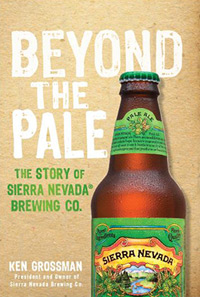 It takes time for a brewery to define itself, but the process can begin with the first batch, even if it gets poured down the drain, and maybe because it does. Six years before Alaskan Brewing dumped brew after brew Sierra Nevada Brewing did the same, in this case ten batches. Co-founder Ken Grossman describes the frustration he an Paul Camusi felt in “Beyond the Pale: The Story of Sierra Nevada Brewing Co.”
It takes time for a brewery to define itself, but the process can begin with the first batch, even if it gets poured down the drain, and maybe because it does. Six years before Alaskan Brewing dumped brew after brew Sierra Nevada Brewing did the same, in this case ten batches. Co-founder Ken Grossman describes the frustration he an Paul Camusi felt in “Beyond the Pale: The Story of Sierra Nevada Brewing Co.”
The first batch of Pale Ale fermented well and tasted good, but they noticed fermentation slowed on the second. Grossman writes, “Brewed on December 23 [1980], Pale Ale number four wasn’t as good as number three. It wasn’t that bad, but the fermentation had dragged on a few extra days; it was just a bit different than the last one. Now we were starting to get concerned by the lack of consistency because we had made the decision that we couldn’t sell beer until we could replicate the batches every time.” They checked ingredients, process, chemistry, equipment, everything they could think of. They were ready to abandon their chosen yeast before they talked to a retired brewmaster familiar with the strain. He provided information that led Grossman to make a simple modification and the eleventh batch fermented very quickly and “tasted great.”
Grossman writes candidly about quality and consistency issues at fledgling breweries in the 1980s and ’90s, adding, “We knew that a bad experience with one craft beer would taint us all in the eyes of consumers, so we tended to help each other out to solve problems when we could.”
Sierra Nevada has always invested in technology and research, and, although Grossman might suggest it is simply a matter of being practical, has been particularly generous in sharing company knowledge. He doesn’t argue that every brewery take that approach.
In some cases owners may prefer not to keep investing and take resources out of a company; after all, isn’t that why you’re in business, to make money? What drove me and many others into the business was the desire to make great beer. Sure, I was a businessperson, too, and I realized making a profit was essential to my ability to brew beer for a living, but I was not enticed into the industry based on profit motive.
He compares meeting the demands a brewery puts on financial resources to tending to a nest of hatchlings.
For me, continuing to invest in our beer and its quality whether it be through equipment for our labs, improving infrastructure or, more recently, in marketing and brand support, was never a question … (Many) seemingly small decisions were critical and set the stage for failure or success.
That’s what happens with time. North Coast Brewing co-founder Mark Ruedrich talked about this in a story I wrote for All About Beer magazine about breweries celebrating 25 years of business this year (that issue is headed to newsstands now). “A lot happens just by surviving. You have the opportunity to make good beer,” Ruedrich said. “Then you can try different things other people haven’t done before.”
This isn’t unique to beer. When author Paul Lukacs chose the wines to include in “The Great Wines of America” he had one firm criterion in his selection process, that any entry had to have a least a ten-year track record. This presumably allows him to assess year-to-year variations within the vineyards themselves. The saying “farmers make wine and engineers make beer” aside, beer is likewise an agricultural product.
However, while wine drinkers might enjoy talking about the differences from one vintage to the next beer drinkers expect consistency, exactly what the Larsons and Grossman were talking about from the beginning. Consumers know what their beer is supposed to taste like, and although exactly alike might be a mythical beast the difference between good and bad is an important divide.
Bernard Kuhn, who brews at the smallish Weissbräu Freilassing hotel and brewery in southeastern Bavaria, has little patience for brewers who don’t know that difference. “You cannot always do the same process because every year the malt is different,” he said. “You have to brew good beer out of shitty malt. That’s the skill of the brewmaster.”
It’s an acquired skill. Mark Matheson studied both winemaking and brewing at UC-Davis (University of California, Davis). Now he brews the beer at Turtle Mountain Brewing, a New Mexico brewpub, and also operates his own winery. “In brewing and making wine anything you do is experience – ‘have you seen it before?'” he said. “Whether it is wine or beer I think you have to do it about 10 years to get a grasp.”
Like Alworth, Matheson gives us a minimum. It’s too early for a brewery founded in 1990s; it takes about 10 years to get a handle on fermentation science. I don’t think it is important to pick a particular number — and the controversy surrounding what some call “Malcolm Gladwell’s 10,000 hours of practice rule” should make that obvious.1 Instead, listen to what Garrett Oliver, brewmaster at Brooklyn Brewery, told European Beer Bloggers Conference attendees last July.
Near the end he talks about “fronting” — when a new brewery presents itself as something it may expect to be, but isn’t yet. He conjures up an image of a peacock spreading its feathers, then makes it clear there is no substitute for time.
“But you haven’t got it, you haven’t got it yet, not five years in, not ten years in, let me tell you, not 15 years in,” he says. “Only now, after 20-some odd years am I getting anywhere near being the brewer that I’ve wanted to be, that I said I was.”
*****
1 Gladwell addresses recent criticism here, and David Epstein’s “How Athletes Get Great” in Outside magazine is a good read despite not being related to beer or brewing. If you really want to kill some time you might cuddle up with “This Is Your Brain On Music.”
In it author Daniel Levitin writes, “Ten thousand hours of practice is required to achieve the level of mastery associated with being a world-class expert-in anything. In study after study of composers, basketball players, fiction writers, ice skaters, concert pianists, chess players, master criminals, and what you, this number comes up again and again. Ten thousand hours is equivalent to roughly three hours a day, or twenty hours a week, of practice over ten years. No one has yet found a case in which true world-class expertise was accomplished in less time.”
And: “The ten-thousand-hours theory is consistent with what we know about how the brain learns. Learning requires the assimilation and consolidation of information in neural tissue. The more experiences we have with something the stronger the memory/learning trace for the experience becomes.”
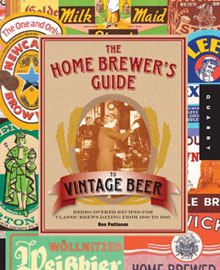 Appropriately enough, last time I looked, Amazon told me that “Home Brewer’s Guide to Vintage Beer” and “Amber, Gold & Black: The History of Britain’s Great Beers” are frequently bought together (along with “Water”).
Appropriately enough, last time I looked, Amazon told me that “Home Brewer’s Guide to Vintage Beer” and “Amber, Gold & Black: The History of Britain’s Great Beers” are frequently bought together (along with “Water”).